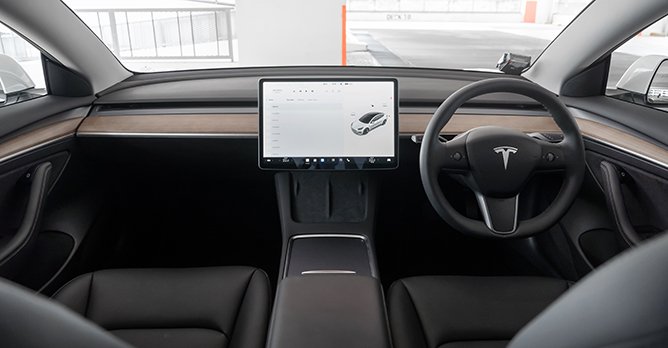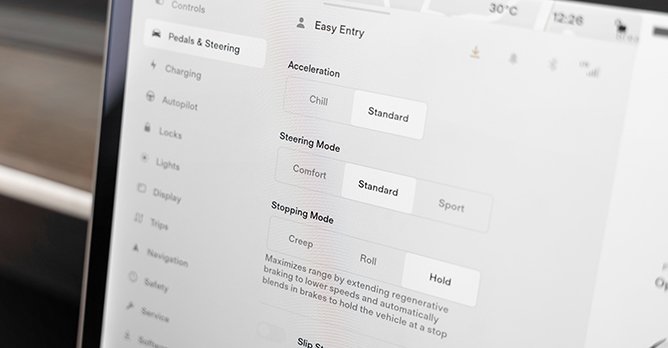Tesla Model 3 Electric Standard Range Plus RWD 50 kWh (A) Review
04 Mar 2022|10,703 views
What We Like
Minimalist cabin feels light and airy
Highly effective electric powertrain
Good battery technology with better efficiency than most competitors
Rides with great composure
Access to Supercharger network
Conversation starter everywhere you go
What We Dislike
Autopilot (currently) isn't what many imagine or expect it to be
Steering is very heavy
Throttle modulation at low speeds is difficult
Build quality isn't quite there yet
We've all seen the Facebook videos, right? Teslas rocketing off at a traffic light, leaving even supercars in their dust. That electric party trick is a pretty well-established one, what with the Model 3 Performance's 660Nm of instant electric torque.
What if you want a slightly tamer experience, then? Well, you can opt for this model - the Model 3 Standard Range Plus.
Pared down
This is the base model Tesla, not that you'd really know by looking at it. It looks basically identical to the Performance model. Is it a pretty car? That's up to you. It reminds me of the robots from the Will Smith I, Robot movie, and while I admit it's certainly distinctive, I don't find it particularly nice to look at.
The interior is very minimalist, and that certainly has advantages. It feels spacious, light and airy, with no feeling of clutter at all. The gigantic centre screen is where you control close to all of the car's functions. For drivers who are used to having multiple buttons and controls, it can initially be confounding trying to find the various functions (like adjusting the mirrors, unlocking the doors and so on). It is a purposefully simplified design with the consideration that most features (like your steering wheel and mirror positions) are set and forget, so in that regard I think it works. Just make sure to give yourself a little bit of time to figure out where everything is.
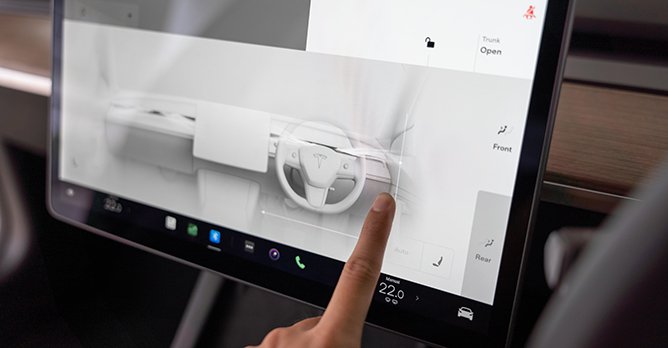
Tesla's lack of car-building experience shows, though. Build quality isn't the greatest. Some of the door seals are a tad flimsy, the two stalks behind the steering wheel are a little clunky, and overall the car lacks the sense of polish you'd get in a German-branded model, for example. And, when you are driving at speed, wind noise is apparent, and you can also occasionally hear some rattling noises.
One motor way
There's obviously been a ton of hype about Tesla's self-driving capabilities. However, the truth is the Autopilot system is a Level 2 system, which primarily means that you still have to keep your hands on the wheel and pay attention.
As a result, you will actually be doing a lot of the driving. And here, there's a lot to like. This Standard model makes do with just one electric motor, but there's still ample pace, with 321bhp and 420Nm of torque to dispatch the 0-100km/h sprint in 5.6 seconds. The ride is very good - smooth, well-damped, and well-controlled. Through corners, the car also holds itself admirably well, with a good sense of dynamic sharpness aided by the rear-wheel drive setup.
One thing to note is that unlike the Performance model, this car is strictly one-pedal drive only. You don't have the option to switch off the regenerative braking when you come off the throttle. And, the braking is pretty strong, which definitely takes a little adjusting to.
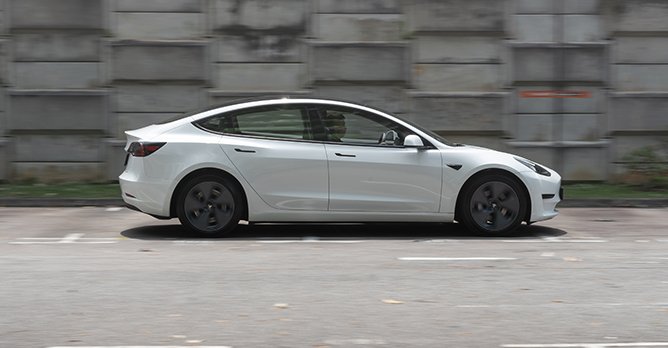
As far as efficiency goes, I managed 6.3km/kWh, not too far off Tesla's claimed 6.9 figure. And, it's a testament to Tesla's battery technology that is a fair bit better than most other EVs in the market right now.
There are, however, two specific things that I don't like. The first is the steering - even in the Comfort setting, it is too heavy for my liking. Especially when going through a carpark at low speeds, it can be really tiring. I wish there was an even lighter setting.
Secondly, the low-speed throttle modulation is not very good, especially if you use the Hold function (which is my preference). Because the throttle is quite spiky and the regenerative braking quite strong, trying to modulate the throttle when reversing into a parking space is honestly frustrating. Furthermore, you can't turn the creep function on unless you first shift the car into 'P'. This is a car where I would say you'd have to turn the creep function perpetually on.
Standardised
This base Model 3 is about $42,000 (as of 24 December 2022) cheaper than the Performance model. And that's a big number. And when it comes to choosing between the two, it chiefly comes down to whether you like or can live with the somewhat stark one-pedal feel (some people vehemently hate it). If you can, then I think this is certainly the Model 3 to have. Yes, you won't be winning as many traffic light races as the Performance, but honestly, the fascination and exhilaration of that rabid acceleration will wear out over time.
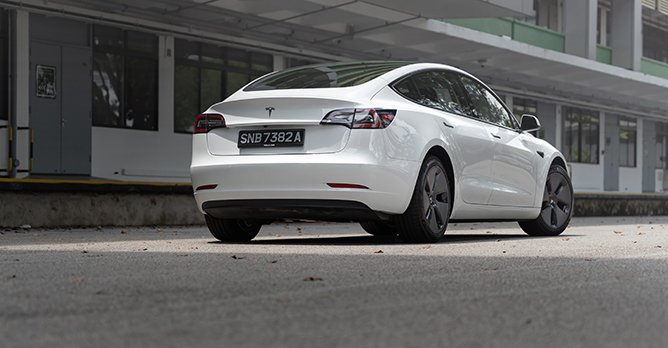
This variant also still does many of the important things that a Tesla should - you get access to the Supercharger network, the (hopefully) growing capabilities of the Autopilot system, and perhaps most importantly, you can tell people that you own a Tesla.
Isn't that currently what it's all about, eh?
In the market for a four-door electric sedan? Here are some other choices in this segment to consider:
The Tesla Model 3 Performance is uniquely different, with power aplenty and a clever autopilot system
The Polestar 2 Long Range Dual Motor makes a strong impression with its capable drivetrain, premium cabin and keen attention to detail
The Polestar 2 Long Range Single Motor proves that less can indeed be more
What We Like
Minimalist cabin feels light and airy
Highly effective electric powertrain
Good battery technology with better efficiency than most competitors
Rides with great composure
Access to Supercharger network
Conversation starter everywhere you go
What We Dislike
Autopilot (currently) isn't what many imagine or expect it to be
Steering is very heavy
Throttle modulation at low speeds is difficult
Build quality isn't quite there yet
We've all seen the Facebook videos, right? Teslas rocketing off at a traffic light, leaving even supercars in their dust. That electric party trick is a pretty well-established one, what with the Model 3 Performance's 660Nm of instant electric torque.
What if you want a slightly tamer experience, then? Well, you can opt for this model - the Model 3 Standard Range Plus.
Pared down
This is the base model Tesla, not that you'd really know by looking at it. It looks basically identical to the Performance model. Is it a pretty car? That's up to you. It reminds me of the robots from the Will Smith I, Robot movie, and while I admit it's certainly distinctive, I don't find it particularly nice to look at.
The interior is very minimalist, and that certainly has advantages. It feels spacious, light and airy, with no feeling of clutter at all. The gigantic centre screen is where you control close to all of the car's functions. For drivers who are used to having multiple buttons and controls, it can initially be confounding trying to find the various functions (like adjusting the mirrors, unlocking the doors and so on). It is a purposefully simplified design with the consideration that most features (like your steering wheel and mirror positions) are set and forget, so in that regard I think it works. Just make sure to give yourself a little bit of time to figure out where everything is.

Tesla's lack of car-building experience shows, though. Build quality isn't the greatest. Some of the door seals are a tad flimsy, the two stalks behind the steering wheel are a little clunky, and overall the car lacks the sense of polish you'd get in a German-branded model, for example. And, when you are driving at speed, wind noise is apparent, and you can also occasionally hear some rattling noises.
One motor way
There's obviously been a ton of hype about Tesla's self-driving capabilities. However, the truth is the Autopilot system is a Level 2 system, which primarily means that you still have to keep your hands on the wheel and pay attention.
As a result, you will actually be doing a lot of the driving. And here, there's a lot to like. This Standard model makes do with just one electric motor, but there's still ample pace, with 321bhp and 420Nm of torque to dispatch the 0-100km/h sprint in 5.6 seconds. The ride is very good - smooth, well-damped, and well-controlled. Through corners, the car also holds itself admirably well, with a good sense of dynamic sharpness aided by the rear-wheel drive setup.
One thing to note is that unlike the Performance model, this car is strictly one-pedal drive only. You don't have the option to switch off the regenerative braking when you come off the throttle. And, the braking is pretty strong, which definitely takes a little adjusting to.

As far as efficiency goes, I managed 6.3km/kWh, not too far off Tesla's claimed 6.9 figure. And, it's a testament to Tesla's battery technology that is a fair bit better than most other EVs in the market right now.
There are, however, two specific things that I don't like. The first is the steering - even in the Comfort setting, it is too heavy for my liking. Especially when going through a carpark at low speeds, it can be really tiring. I wish there was an even lighter setting.
Secondly, the low-speed throttle modulation is not very good, especially if you use the Hold function (which is my preference). Because the throttle is quite spiky and the regenerative braking quite strong, trying to modulate the throttle when reversing into a parking space is honestly frustrating. Furthermore, you can't turn the creep function on unless you first shift the car into 'P'. This is a car where I would say you'd have to turn the creep function perpetually on.
Standardised
This base Model 3 is about $42,000 (as of 24 December 2022) cheaper than the Performance model. And that's a big number. And when it comes to choosing between the two, it chiefly comes down to whether you like or can live with the somewhat stark one-pedal feel (some people vehemently hate it). If you can, then I think this is certainly the Model 3 to have. Yes, you won't be winning as many traffic light races as the Performance, but honestly, the fascination and exhilaration of that rabid acceleration will wear out over time.

This variant also still does many of the important things that a Tesla should - you get access to the Supercharger network, the (hopefully) growing capabilities of the Autopilot system, and perhaps most importantly, you can tell people that you own a Tesla.
Isn't that currently what it's all about, eh?
In the market for a four-door electric sedan? Here are some other choices in this segment to consider:
The Tesla Model 3 Performance is uniquely different, with power aplenty and a clever autopilot system
The Polestar 2 Long Range Dual Motor makes a strong impression with its capable drivetrain, premium cabin and keen attention to detail
The Polestar 2 Long Range Single Motor proves that less can indeed be more
Also read our comparison article on:
Tesla Model 3 vs Hyundai Ioniq 6Car Information
Tesla Model 3 Electric
CAT B|Electric|8.2km/kWh
Horsepower
208kW (279 bhp)
Torque
420 Nm
Acceleration
6.1sec (0-100km /hr)
Thank You For Your Subscription.






































